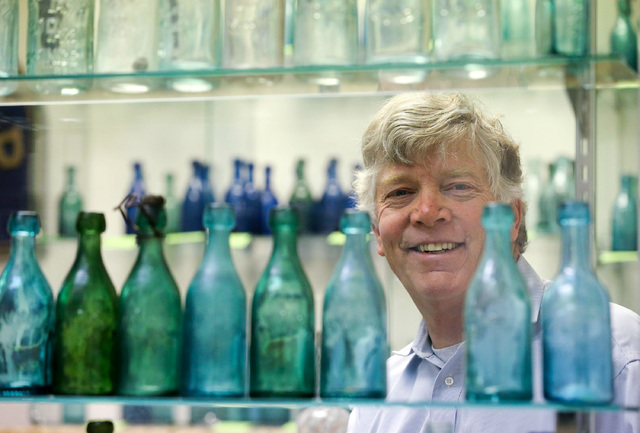Reno author shares Nevada’s colorful past through collection of antique drugstore vials

They’re not just bottles. They’re mirrors that reflect Nevada during a different time, prisms that break up the sunlight of modern-day Nevada into the earthier colors of the state’s mining tradition.
But, yeah, some of them look pretty cool, too.
Drugstore bottles from long-ago Nevada towns have been a passion of Fred N. Holabird’s since his college days at Humboldt State University in California. In his second book, “Ghost Towns & Medicines: The Nevada Bottle Book Volume II — Drug Store Bottles” (Sierra Nevada Press, $42), Holabird, a Reno mining geologist, shares his love of antique bottles, not just as collectibles but as historical relics.
Holabird’s first volume dealt with embossed soda, whiskey, beer and dairy bottles. This time, he focuses on the bottles both fancy and utilitarian that Silver State druggists used in providing medical care to miners and pioneers.
But readers who expect to see page after page of bottle pictures will be surprised. While photos are plentiful — along with information that hard-core collectors will find useful — Holabird’s book can be read as fascinating social history.
Holabird, 63, found his first embossed bottle — a Spruante & Stanley purple pumpkinseed whiskey bottle from about 1885 — during a college geology field excursion in Calfornia. It intrigued him, not just because of what it was but also because of the human history it represented.
“Then I got more interested when I found out there were bottles like this from those ghost towns where there’s nothing left,” he said. “I got more and more intrigued. Then, you realize that some of these (druggists) — in fact, most of them — had a finger in the mining business.”
William H. Stowell, for example, a New Yorker who headed west in 1866 and opened one of the first drugstores in Eureka. A decade later, he added assaying to his business, investing about the same time in drug bottles embossed with his name and business.
Stowell’s is an example of “what I call the itinerant drugstore, because they had to follow the next mining boom,” Holabird said. Druggists traveled from boom to boom, serving miners and their communities not just as purveyors of medicines but as unofficial community centers.
Through the book, he said, “we are looking at parts of the story that are told through the eyes of the (miners) and merchants who put their name on those bottles, and it’s a different kind of history than you read in the classic social history books.”
It’s the story of druggist John F. Myers of Reno, who died of a morphine overdose in 1885 at the age of 35. And of J.B.B. Lefevre, “the whorehouse doctor up in Virginia City,” who, Holabird writes, catered to the needs of women and the brothel business, taking “an upfront approach to a business some people felt was better left ‘to the other side of the tracks.’ ”
The book even is a business history, Holabird said. “It’s about different kinds of businesses and how they operated. And some of these businesses operated under extremely difficult conditions, because you’re dealing with mining camps in very remote parts of the state that aren’t so familiar and there’s not a lot of cash flow.”
And, it’s a tribute to once-bustling towns and mining camps that no longer exist, such as Seven Troughs in Pershing County, once the home of Owl Pharmacy, and Ruby Hill, near Eureka, both of which “were there for just a moment of time,” Holabird said.
None of this is to minimize the lure of the bottles themselves, which often rank as pieces of personalized, colored, embossed, utilitarian art. The book includes information about the types of drug bottles used throughout Nevada’s history, as well as images of prescriptions, documents and the colorful, sometimes bizarre ads and illustrations druggists used to advertise patent medicine and other products.
Holabird — who was in town this weekend for the 2017 Antique & Collectibles Show & Sale at the Henderson Convention Center — said his goal was to make the book “something that was not only a history book but somewhere where people could learn about the fun aspects of life in Nevada from drugstore guys to mining guys.”
The bottles are “permanent relics of our past,” he said. “Each one of the relics has a story that’s unique, and you won’t find it anywhere else.”
Read more from John Przybys at reviewjournal.com. Contact him at jprzybys@reviewjournal.com and follow @JJPrzybys on Twitter.